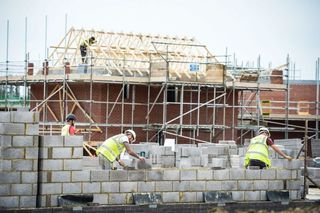Limerick has a spring in its step, and riches await the people who tap into its potential
The Milk Market in Limerick
I've had a soft spot for Limerick since the time a pretty Laurel Hill teenager from Ennis Road whispered to a freckly, 15-year-old redhead outside the ceili at Irish college that she thought he was special.
These are the events you remember from your teenage years, not the hours of trigonometry, the date of the Battle of Clontarf, or any of the other stuff that's crammed into our heads in an effort to make sure we can perform that bizarre feat of memory gymnastics called the Leaving Cert.
In contrast, we are emotionally conditioned to remember experiences. We store them deep inside us. They can be resurrected by a smell, an image or even hearing – out of the blue – whatever album we listened to 20 or even 30 years ago.
If we have to actually learn – as opposed to experience – something, the best way to do this is through a constant process of reinforcing and continual repetition.
Regular reinforcement of lots of small messages repeated at timely intervals is how we form impressions, develop opinions and yes, develop prejudices. If the messages are constantly negative, we all form commensurate opinions.
With regards to Limerick, the messages that are constantly replayed, relayed and rehashed about the city seem to me to be relentlessly negative. The city gets a bad rap. The image is one of out-of-control violence, where feral gangs roam the streets and terrorise the average citizen. This dystopia is constantly reinforced in the media. I don't need to remind you that the shorthand for Limerick is "stab city" – most often portrayed as a desolate place you'd best avoid.
But walking around it, I see something quite different. If it were so desolate, then why do you think that Brown Thomas, Limerick, has had faster-growing turnover this year and last than either of its Cork or Dublin stores?
Architecturally, the centre of Limerick is a Georgian gem, the riverfront is beautiful and the surrounding countryside a tourist mecca. It has a huge university, an international airport and, in Thomond Park and Munster rugby, one of the most internationally recognisable Irish sporting brands.
On Saturday, I sat in Limerick's cosmopolitan Milk Market. There can hardly be a better 'covered market' in Ireland. While eating gorgeous toasties at the redoubtable Marie Hussey's Cheese Shop, Mickey Dunne, the master uilleann piper – a fully paid-up member of Ireland's trad aristocracy – started to play in the corner, there and then, as punters came in and out buying cheese, coffees, buns, and plonking themselves down to chat and listen. Outside, the market bustled with the intense chatter of commerce.
I say "trad aristocracy" because Mickey Dunne has pedigree. His father (the legendary Pecker Dunne) and uncles were highly regarded buskers at fairs, markets and GAA matches. They were travelling musicians who played widely and influenced many well-known names including Seamus Connolly, Tony McMahon and Professor Mick Maloney.
This is deep culture. It is Irish culture, the culture that is in our DNA, the type of culture you cannot fake, and here it was playing on Saturday morning.
The night before, I was hosting an economic and political debate as part of the Limerick Spring, itself part of the City of Culture. The discussion was held at the hopping Dolans Warehouse.
It is a brilliant venue – as good as any in the country – which every month plays host to dozens of musicians, comedians and the odd travelling economist, too.
As I immersed myself in the buzz of the Milk Market, it struck me that there was no reason why Limerick could not be an economic and cultural success in the future – a model of urban regeneration and a place where people want to live.
Cities are the key to economic growth; they have their own dynamic and, if this is tapped into, it can create a self-reinforcing virtuous cycle. In the United States, many cities – which have fallen on hard times because the few industries that sustained them collapsed – have reinvented themselves, always through a combination of small businesses, driven by public-private partnership.
What you need is a city where rents are cheap, where the workers are also relatively good value and hungry, where there are people willing to take risks and where there is a sufficient pool of capital – that is, there are a few rich people willing to back those people's dreams.
At an average cost of €135,000, houses in Limerick are now the cheapest urban homes in Ireland. This is a good thing. Average rents stand at €580 per month, compared with €1,400 plus in south Dublin. Again, cheap accommodation is a competitive advantage.
Skilled workers are cheaper in Limerick. For example, in Dublin, a senior software developer role would command a salary of about €65,000, whereas in Limerick it would be more like €50,000.
So, housing and wages are 60pc and 20pc cheaper, respectively, in Limerick than in Dublin. This is all good for the efficacy of any investment.
Additionally, the recent Irish 'Rich List' revealed that the seven richest Limerick people have net assets of €1bn. Surely they could be persuaded to use some of this to seed new business in the home city?
Small young businesses are the ones that create jobs. They set up largely in cities and if they are involved in selling something for export, or if they are trying to undercut other businesses, lower wages and lower rents are a huge plus.
Without business and income, urban regeneration is impossible but, with it, urban renewal tends to happen from the centre city out and is best done street by street or small block by small block. The State can help by taking obvious steps. Here are three:
First, I couldn't help noticing that on Limerick's riverfront, there are so many buildings used solely for municipal purposes. Surely moving things such as the revenue offices to one of the many empty buildings elsewhere would be beneficial?
These new empty buildings with lovely views of the Shannon could be turned into residences. This would start the process of reinvigorating the Georgian city centre. Where people live, businesses naturally pop up to service them.
Second, peripheral Limerick's retail parks have drained the lifeblood of the city. Stop building them.
Third, the University of Limerick's plans to build a city-centre campus should be accelerated and the empty Georgian buildings converted into student flats.
I am sure locals can think of many more positive steps that could be taken easily. We all know what is wrong with Limerick, but why not point out what is right with it and start from there?
WWW.DAVIDMCWILLIAMS.IE
Join the Irish Independent WhatsApp channel
Stay up to date with all the latest news














